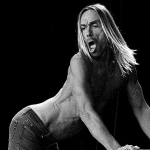 Music
Music  Music
Music  History
History 10 Less Than Jolly Events That Occurred on December 25
 Weird Stuff
Weird Stuff 10 Funny Ways That Researchers Overthink Christmas
 Politics
Politics 10 Political Scandals That Sent Crowds Into the Streets
 Weird Stuff
Weird Stuff Ten Bizarre Facts About The Doge Meme
 Our World
Our World 10 Ways Your Christmas Tree Is More Lit Than You Think
 Movies and TV
Movies and TV The 10 Coolest Stars to Set Sail on The Love Boat
 History
History 10 Things You Didn’t Know About the American National Anthem
 Technology
Technology Top 10 Everyday Tech Buzzwords That Hide a Darker Past
 Humans
Humans 10 Everyday Human Behaviors That Are Actually Survival Instincts
 Music
Music 10 Surprising Origin Stories of Your Favorite Holiday Songs
 History
History 10 Less Than Jolly Events That Occurred on December 25
 Weird Stuff
Weird Stuff 10 Funny Ways That Researchers Overthink Christmas
Who's Behind Listverse?

Jamie Frater
Head Editor
Jamie founded Listverse due to an insatiable desire to share fascinating, obscure, and bizarre facts. He has been a guest speaker on numerous national radio and television stations and is a five time published author.
More About Us Politics
Politics 10 Political Scandals That Sent Crowds Into the Streets
 Weird Stuff
Weird Stuff Ten Bizarre Facts About The Doge Meme
 Our World
Our World 10 Ways Your Christmas Tree Is More Lit Than You Think
 Movies and TV
Movies and TV The 10 Coolest Stars to Set Sail on The Love Boat
 History
History 10 Things You Didn’t Know About the American National Anthem
 Technology
Technology Top 10 Everyday Tech Buzzwords That Hide a Darker Past
 Humans
Humans 10 Everyday Human Behaviors That Are Actually Survival Instincts
10 Influencers Who Lived Centuries before Social Media
What do you think of when you read the term “influencer”? You probably envision a young woman modeling clothes or some other product in Instagram posts, right? Or maybe she’s over on TikTok selling some random product to her millions of followers and trying to take a cut of the profits from her advertising work. Influencers have bubbled up to become something much bigger than a cottage industry in the last few years. It is seemingly everywhere online. Whenever we log onto any social media app or network, somebody is there ready to influence us into buying this thing or trying that thing.
But there were influencers long before social media, too. And long before the internet at all, in fact! In this list today, we’ll take a look at ten of those influencers. These men and women from decades (even centuries!) ago were trendy, highly visible, and heavily copied. Consider them the world’s first influencers, then. We can’t help but wonder what Instagram and TikTok would have been like had some of these historic people been around to log on!
Related: 10 Royal Imposters Who Nearly Got Away with It
10 Queen Elizabeth I
Smallpox was brutal on many households across Europe through the 16th century. Even royal households. In 1562, Queen Elizabeth I of England contracted smallpox. She very nearly died, though thankfully didn’t. But it left her with scars all over her body that could be very easily seen by the naked eye. And because she had such a high profile on account of her birthright, she needed to seem beautiful and regal to the masses. So she started a trend that still lives on today: the idea of wearing makeup to cover up blemishes and other flaws on one’s face.
The queen concocted a mixture of lead and vinegar that created a white paste, which she regularly applied to her face. For a while, she used it merely to conceal her scars. But it wasn’t long before the makeup move went mainstream, and other people began to copy her. After all, she was England’s most visible woman—and under constant scrutiny.
Because she was so well recognized by the masses, soon many women began to use makeup just like Queen Elizabeth. She started a trend that carried across classes (well, with whatever poor people could afford to do at the time, anyway.) From there, a perfectly white face came to symbolize youth and wealth. And now, well, we all know how massive the makeup industry has become![1]
9 Giuseppe Garibaldi
Giuseppe Garibaldi was most well-known during his life for being the man who fought for the unification of Italy. As a general, he battled hard for his home nation’s eventual status as a kingdom in the mid-19th century. But his influence didn’t end there. Even though he was a military man through and through, Garibaldi also had an influence on… fashion? Yes, really!
Garibaldi was in charge of a small and mostly rag-tag little army at one point. To fight, they wore baggy red shirts instead of uniforms since, well, they didn’t have any uniforms. But Garibaldi’s fighting was very admired. And his devotion to his cause naturally attracted people to his perspective. So, in turn, people began to adore the red shirts his men wore while fighting so bravely, too.
In a show of support, women in Italy began donning those same red shirts in their day-to-day lives. The shirts were fashionable because they were tied to Garibaldi’s cause. But they were also practical, easy to wear, easy to make, and flexible enough to be worn while working, too. Soon enough, they became iconic in Garibaldi strongholds all across Italy.
The so-called “Garibaldi shirt” could be seen all over the place. Eventually, decades later, it became a common contribution to the various ladies’ fashion magazines that started popping up. In turn, it even ended up being the predecessor to the blouse, which is now an everyday staple of the feminine wardrobe. Who knew a military man could have such an impact on fashion?![2]
8 Madame Wellington Koo
The first lady of the Republic of China from late 1926 through 1927 was a woman named Oei Hui-lan. Better known to the English-speaking world as Madame Wellington Koo, she left her mark on history in quite a few ways. But the one we remember most for now is the sense of style she carried, for it brought Chinese fashion to the forefront at a time when it was otherwise completely ignored by the rest of the world.
Undoubtedly, Madame Koo’s most lasting fashion move was the mass adoption of the “qipao.” Also called the “cheongsam,” it was a traditional Chinese garment that had long been worn in that nation. It was a robe-like dress with adornments and intricate designs. Historically, it had been intended to only be worn by members of the Chinese upper classes. But Madame Koo re-envisioned the garment, made it a figure-hugging dress, and cut a side slit up along the hip that developed it into an even more fashionable outfit.
In turn, her new spin on the traditional Chinese dress was well received by women both in China and around the world. Even though she wasn’t a political figure for very long, the dress had a lasting impact on the fashion that came out of mainland China. Women began to emulate her. Since women from all classes were now taking the lead, her influence was felt top-to-bottom through the early part of the 20th century.[3]
7 Morris Frank
Morris Frank grew up in a reasonably wealthy family in Tennessee in the early 20th century. But when he was just six years old, he lost an eye in a horrible horseback riding accident. Then, to make matters worse, he lost sight in his other eye ten years later. Suddenly, completely blind and still just a teenager, he needed some help.
In 1927, the then-20-year-old Frank heard about a woman named Dorothy Eustis, who was training German Shepherd dogs in the United Kingdom to help lead blind war veterans in their daily activities. Interested in what that might do for him, Frank reached out to Eustis. He wanted to establish a similar training program in the United States. And the rest soon became history.
After finally meeting Eustis, Frank carefully trained a guide dog of his own. He then went about his daily life in a very public fashion. His “normal” life with the seeing-eye dog working by his side made people look on in amazement. This completely blind man could do everything that “normal” folks could do!
For the rest of his life, Frank was capable, independent, and completely active in his community. In turn, his story of using a seeing-eye dog (the first one specifically trained for the purpose and defined as such in the United States) became hugely influential. Under his guidance, the Seeing Eye organization began work in the US, and soon, blind people all over the country had canine assets to help them out.[4]
6 Queen Victoria
Queen Victoria’s wedding was so iconic and influential that she didn’t just alter fashion with it—she created an entirely new category. Married in 1840, Queen Victoria wore a white off-the-shoulder lace dress. And while it wasn’t the first-ever white wedding dress ever worn for a marriage ceremony, it was by far the most high-profile instance of one.
Immediately, the publicity stemming from her wedding made a white wedding dress the new standard for brides from all social classes and backgrounds. Descriptions of the dress circulated through newspapers at the time (the ancient social media, one might say!), and women were enthralled with Victoria’s look. They simply needed to have it for themselves.
Soon enough, the fashion industry began to change, too. Through the 19th century, synthetic fibers were starting to make their way into the fashion world more frequently. Those fibers, in turn, allowed for more mass production of clothing and wedding dresses.
Soon, women from all walks of life were able to copy Queen Victoria and wear lacy white wedding dresses on their big day. And that’s what they did! The queen became a fashion icon because of her choice to rock white and walk down the aisle. And now, some would say that the wedding industry has never been the same ever since.[5]
5 William Dorsey Swann
In 1888, a man named William Dorsey Swann hosted a drag queen ball in the city of Washington, D.C. Swann had been hosting those balls for a long time by then, and they were always secret. They were attended by dozens of Black men who dressed up in fashionable women’s gowns. But that one was infiltrated by the police. Most of the men involved fled for their lives, but Swann stayed behind. He was arrested and hauled off to the police station. Once there, he was booked. Newspapers from the day covered the story, with some even calling him the “Queen” of the event. Soon enough, that phrase—drag queen—took hold. And from there, it was history.
Swann’s impactful life in the late 19th century was one of transgression. His 1888 move to be willing to get arrested for his no-longer-secret drag queen events made him one of the first LGBT resistance fighters ever known. In the end, he was the first person to openly refer to himself as a drag queen.
He went on to host more balls like that with lavish singing and dancing—and no shame or secrecy in who he was and what he loved to do. In that way, Swann was perhaps the earliest LGBT influencer ever known. And his impactful move would affect gay culture downstream for decades and decades to come.[6]
4 Emiliano Zapata
The mustache has obviously existed for a very long time. But nobody did it quite like famed Mexican revolutionary leader Emiliano Zapata! In the early 20th century, while he was taking part in the Mexican Revolution and specifically fighting for the justice of peasants in the south of the nation, Zapata rocked a mustache that was extremely bushy and full. Because he was so popular with regular poor folks down in Mexico, his entire persona was heavily copied and revered.
Soon enough, that turned into a natural mimicry of his mustache by many other Mexicans who wanted to show their support for his cause and beliefs. In turn, Zapata’s decision to always wear his mustache (and always have it expertly groomed!) ensured that the hair above his upper lip was no longer just an aesthetic choice. It became tied very tightly to the revolution itself.
In just a few years, his mustache became a sign of Mexican patriotism. The thick mustache above the lip, the curved hair angling downward on each side of the mouth—whenever anybody saw that mustache out in their villages, they associated it with Zapata’s face and the fight for peasants’ rights. Talk about an early meme that went around years before the internet ever existed![7]
3 Amelia Bloomer
In 1848, women all across the United States were dead-set on achieving greater participation within the government. That year, the Seneca Falls Convention was hosted to give a greater voice to women who wanted more political influence and power. Naturally, some of the women who were at that event made their way into the public consciousness. Chief among them was one attendee in particular: Amelia Bloomer.
She was one of the women who used that event to create “The Lily,” a newspaper that was all about women’s rights with a heavy side dish of temperance activism. But the newspaper itself wasn’t the influential story here. If you know anything about Amelia Bloomer, you undoubtedly know her last name. That’s because Bloomer felt very strongly that the common clothing expected to be worn by women at that time—corsets and tight-fitting dresses—was far too restrictive to the female body. She wanted women to be able to wear something more freeing and comfortable.
Therefore, she created a garment that went under a skirt and was actually comfortable: full-cut pantaloons. Other women before Bloomer had worn things like that at times, but she perfected the design. And with her high-profile status from the Seneca Falls Convention and The Lily, she became tied up in it very quickly, too. Those pantaloons quickly came to be called “bloomers,” and the garment (and its name) spread like wildfire all over America.[8]
2 King Louis XIV
The wig was used in several various points throughout history by the time King Louis XIV arrived on the scene in the middle part of the 17th century. After all, it was the French monarch’s father, King Louis XII, who first made wigs somewhat stylish for the upper classes when he began to wear one after balding came for him in the 1620s. However, it was the fact that Louis XIV wasn’t bald that actually made the wig so stylish after he ascended to the throne following his father in 1643.
See, Louis XIV had an extremely luscious head of hair. He had a naturally thick mane of black hair that flowed seemingly endlessly. He looked so good, in fact, that his hair became the new beauty standard for royal family members all across Europe. Royals and aristocrats alike desperately wanted to have hair just like the French king. The problem was that most of them didn’t have his thick and naturally flowing locks. And many of those poor souls were already beginning to bald, too—or had long before gone bald. So, wigs became the fashion move for high-class men.
Desperate to follow the trend accidentally set by Louis XIV’s wonderful hair, courtiers in France and across Europe started to don wigs. King Charles II of Great Britain and Ireland very notably wore a wig beginning in 1663 to conceal the graying of his formerly black hair. Other royals and aristocrats across the continent followed suit, too.
The irony, though, is that by 1673, Louis XIV’s own hair had begun to thin. So he made the move to add false hair to his scalp to keep things appearing robust. In that way, the (accidental) influencer got caught up in the maelstrom of his own influence. And so did everybody else![9]
1 Ambrose Burnside
Ambrose Burnside was an iconic Union General during the American Civil War. He was also the governor of Rhode Island for a time after the war. He even served as a United States Senator representing Rhode Island, as well. So, to say that he was a powerful man and a very politically connected American is putting it mildly. None of that stuff really matters, though, at least not for our purposes here. Today, Ambrose Burnside is only remembered for one single thing: the creation of the sideburns. Heck, they are even named after him!
To be fair to those who came before Burnside, he wasn’t the progenitor of the sideburn trend. But his sideburns were so exquisite and bushy that it was sort of hard to ignore them. Look at a picture of the guy; they are pretty much the only thing you can notice when you see it! He’d been forced to keep a clean-cut appearance as a young man while receiving his education as a cadet at West Point, and he’d hated it. So, as he got older and he was thus able, he grew out the hair on the sides of his face and got creative with it. The rest is history.
Because he was such a military hero and a notable public figure at the time, the public took obvious interest in his sideburns. And because they were so undeniably full and thick, Americans sort of couldn’t look away. Oh, and it also helped that he rose to political power right when photography was beginning to become viable as a new technology. So, photographs of him were spread further and wider than any photos of politicians before his era. His name was used to come up with a term for the look, too. Originally, they were known as “burnsides.” Somewhere along the way, those words got flipped. And now, we’re left with sideburns. Voila![10]








